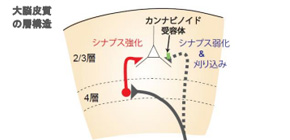
Scrapping excessive neural connection helps build new connections
Possible self-organizing mechanism of neuronal network formation
Outline
Researchers found that neural activity that retracts excessive early innervation in a certain pathway helps make late neural connections in a different pathway. This may provide a self-organizing mechanism of neural connections, and additionally, early excessive innervation may serve as a guide for making late neural connections.
Comments/messages from researcher(s)
The formation and refinement of neural networks is known to be often an activity-dependent process, but mechanisms and nature of activity are not yet clearly understood.
During neuronal circuit formation, afferent axons often make multiple, exuberant, or aberrant connections, which are later eliminated, sometimes in an activity-dependent manner. Such examples are widely seen throughout the central and peripheral nervous systems.
The finding made by a research group led by Fumitaka Kimura, associate professor at the Graduate School of Medicine, Osaka University indicates that such exuberant early thalamocortical connections are not useless, unnecessary connections but serve to help make L4-L2/3 connections. It will be intriguing to determine whether similar mechanisms might be operating in other systems. In addition, retraction of early thalamocortical connection was driven by cannabinoid type 1 receptor (CB1R). This suggests that external intake of cannabinoids (psychoactive ingredient of marijuana) will retract thalamocortical projection without neural activity. This may result in poor neural formation of L4-L2/3. Thus, intake of cannabinoids may result in a malformation of CB1R-free neurons.
This finding will lead to further understanding of neuronal circuit mechanism and contribute to raising awareness of prevention of cannabis and/or legal drug abuse.
Abstract
Spike timing-dependent plasticity (STDP) has been demonstrated in a variety of neural circuits. Recent studies reveal that it plays a fundamental role in the formation and remodeling of neuronal circuits. We show here an interaction of two distinct forms of STDP in the mouse barrel cortex causing concurrent, plastic changes, potentially a novel mechanism underlying network remodeling. We previously demonstrated that during the second postnatal week, when layer four (L4) cells are forming synapses onto L2/3 cells, L4-L2/3 synapses exhibit STDP with only long-term potentiation (t-LTP). We also showed that at the same developmental stage, thalamus-L2/3 synapses express functional cannabinoid type 1 receptor (CB1R) and exhibit CB1R-dependent STDP with only long-term depression (t-LTD). Thus, distinct forms of STDP with opposite directions (potentiation vs. depression) converge in the target layer of L2/3 during the second postnatal week. As the canonical target layer of the thalamus is L4 and thalamic cells activate both L4 and L2/3 cells, in principle, thalamic activity could induce t-LTP at L4-L2/3 and t-LTD at thalamus-L2/3 simultaneously. In this study, we tested this possibility. We found that when spike timing stimulation was applied to the thalamus and L2/3 cells, synapses between the thalamus and L2/3 were weakened, whereas synapses between L4 and L2/3 were potentiated; therefore, converging STDP caused the predicted concurrent plasticity. We propose that developmentally transient convergences of STDP may play a role in shaping neural networks by facilitating L4-L2/3 formation and weakening aberrant thalamic innervation to L2/3, both driven by thalamic activity.

Figure. Two opposite forms of spike timing-dependent plasticity (STDP) converge onto L2/3, spike timing-dependent long-term potentiation (t-LTP) from L4 and spike timing-dependent long-term depression (t-LTD) from the thalamus during the second postnatal week. Thalamic projection to L4 lost STDP at this age. Thalamic activity may facilitate L4-L2/3 synapse formation by t-LTP, while simultaneously weakening and retracting from direct innervation of L2/3 by t-LTD through CB1R, thus, reorganization of neural circuits may proceed in a self-organizing manner. Illustration adapted from Itami et al (2016) with modifications.
To learn more about this research, please view the full research report entitled “ Concurrently induced plasticity due to convergence of distinct forms of spike timing-dependent plasticity in the developing barrel cortex ” at this page of the European Journal of Neuroscience website.
Related link
